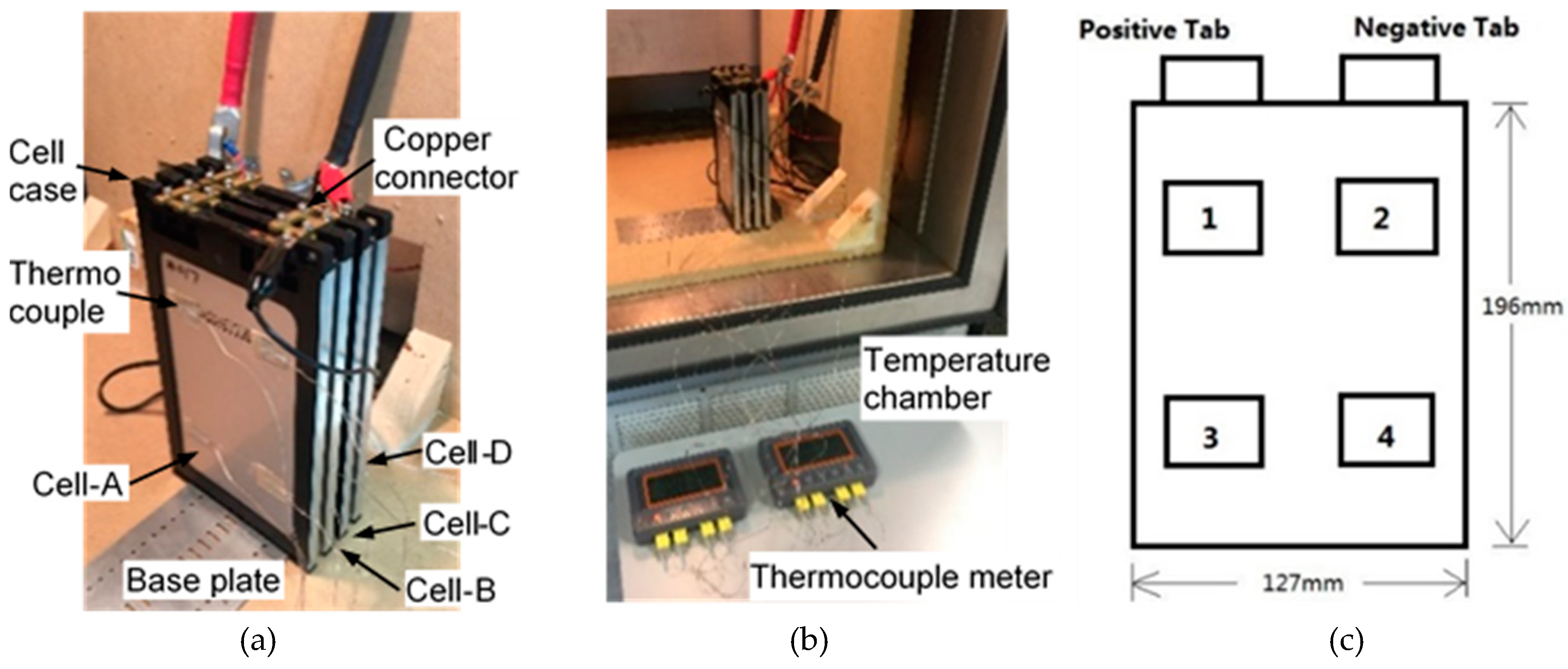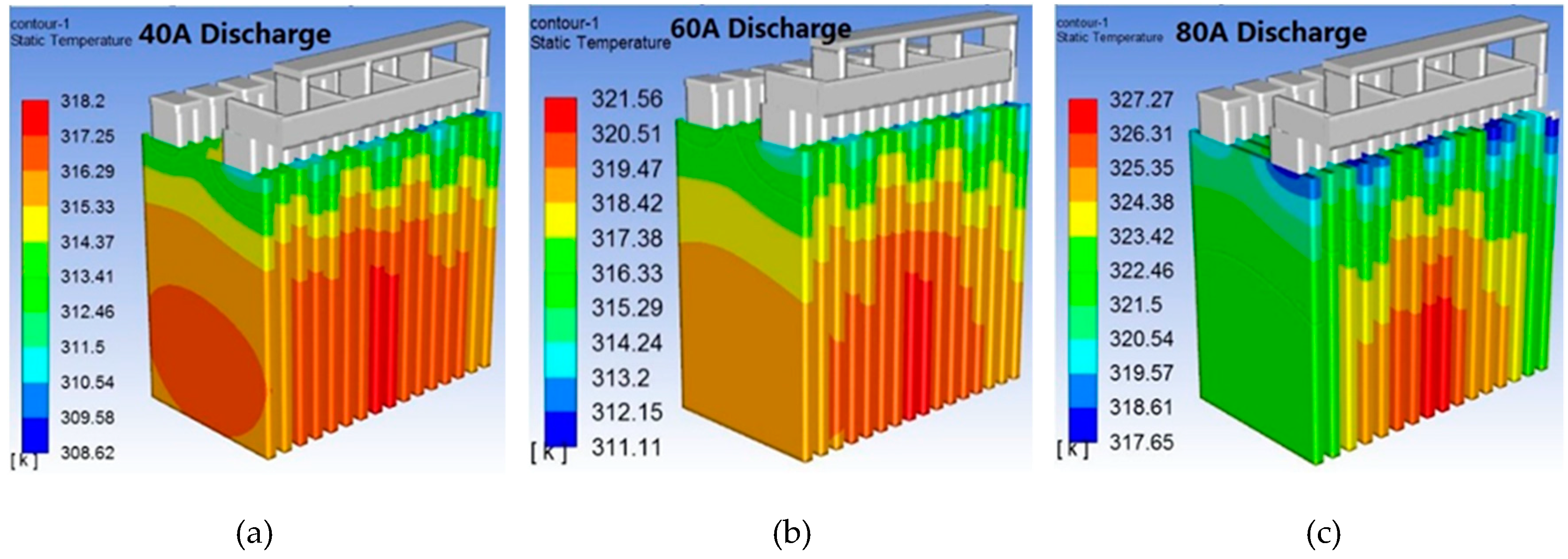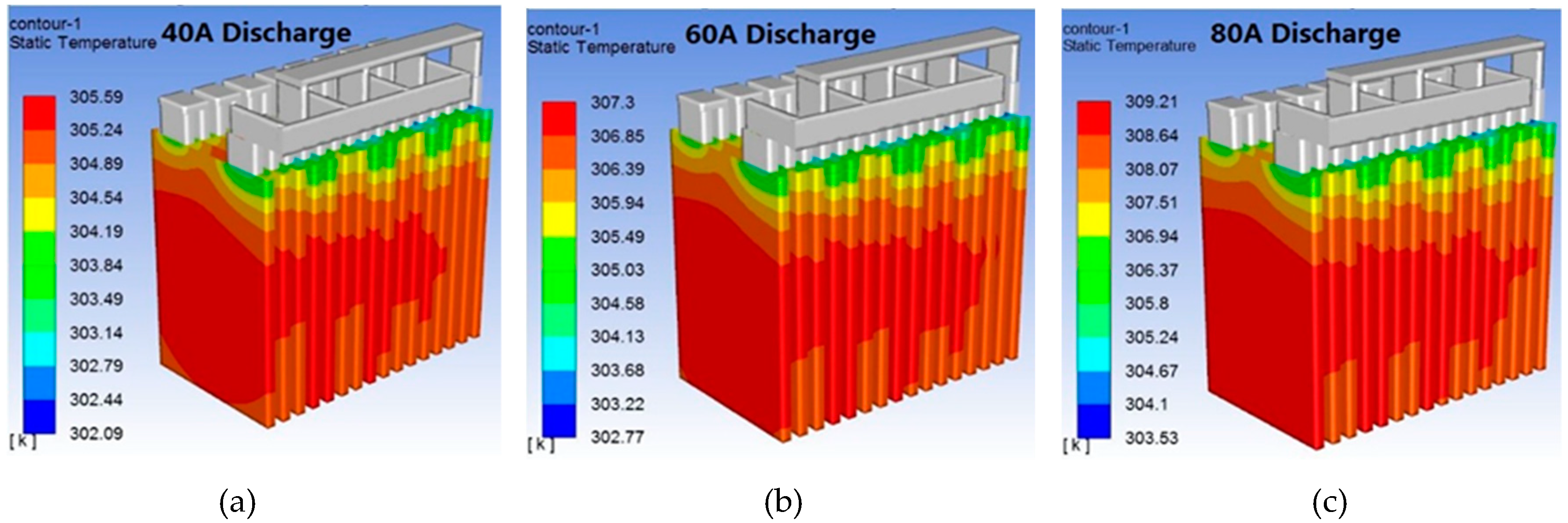Transient Temperature Distributions on Lithium-Ion Polymer SLI Battery
Abstract
:1. Introduction
2. Temperature Experiments of Battery Module
3. Thermal Model of Battery Module
- (1)
- In the DesignModeler, the 3D model of the battery module is created according to the actual size of the EiG ePLB-C020 cell and the actual configuration of the battery module. The dimension sizes of the cell are 127 mm (width) × 196 mm (length) × 7 mm (thickness). The dimensions for the positive and negative tabs are 30 mm (width) × 23 mm (length) × 6 mm (thickness). The dimensions for the three connecting plates are 30 mm (width) × 21 mm (length) × 5 mm (thickness). Also, the gaps between two neighbor cells are 7 mm. The protection cases of the cells are not modeled in the simulation to reduce the complexity of the simulations.
- (2)
- An air volume of 127 mm × 196 mm × 7 mm is created in the space between two neighboring cells, so the space between neighboring cells is completely filled with air.
- (3)
- The mesh of the entire geometry is created with 165,049 nodes and 132,761 elements.
- (4)
- The mesh file is input to the Fluent Setup where the Energy and the Multi-Scale Multi-Domain (MSMD) Battery Model are activated. Considering the tradeoff between accuracy and complexity of all models, the simple semi-empirical electrochemical NTGK Empirical Model is selected in the MSMD Battery Model dialog box. A value of 20 Ah is entered for the Nominal Cell Capacity and specified C-rate is selected for the Solution Option. Positive (for discharge) and negative (for charge) C-rate values can be entered for different tests. The values of 10 V and 16.4 V are entered for the Min. and Max. Stop Voltages, respectively.
- (5)
- Under model parameters, initial DOD is set to 0 for discharging simulations and Initial DOD is set to 1 for charging simulations. All the Y and U Coefficients are determined by the method provided in [15]. Under conductive zones, active components, tab components, and busbar components are assigned. Under electric contacts, the negative tab and positive tab for the entire battery module are assigned.
- (6)
- Copper is selected as the tab and connecting plate material in the Materials input. For the active material inside the battery cell, 2092 kg/m3, 678 J/kg·K, 18.4 W/m·K, and 3.541 × 107 siemens/m are entered for the density, specific heat, thermal conductivity, and electrical conductivity, respectively. The uds-0 and uds-1 coefficients are respectively set to 1190,000 kg/m·s and 983,000 kg/m·s. Air is the selected material for space between two neighbor cells.
- (7)
- The thermal properties of battery cell case walls, positive/negative tabs, and connecting plates are edited in the boundary conditions. The thermal condition is set as mixed for all zones. The heat transfer coefficient is 5 W/m2-K and external emissivity is 0.9. The free stream temperature is set to 298 K which is the temperature inside the temperature chamber.
- (8)
- The SIMPLE scheme is selected as solution methods. The hybrid is the initialization method. An initial temperature is set to 298 K. A fixed time stepping method is used under run calculation. Time step size is set to 60 s and the number of time steps are determined based on the different C-rates.
4. Thermal Model Correlations
5. Extension to a Starting, Lighting, and Ignition (SLI) Pack Thermal Model
6. Integration Cooling System with the SLI Pack Thermal Model
7. Conclusions
Author Contributions
Funding
Conflicts of Interest
Nomenclature
| volumetric current density () | |
| internal resistance of battery cell (Ω) | |
| temperature (K) | |
| temperature coefficient () | |
| OCV | open circuit voltage |
| specific area of the electrode sandwich sheet | |
| , | coefficients used to calculate Y and U |
| , | NTGK model constants |
| DOD | depth of discharge |
| battery total capacity (Ah) | |
| reference temperature (298 K) | |
| Trt | real-time temperature |
| Vol | volume of the battery |
| Y, U | NTGK model parameters |
| , | phase potentials of the positive and negative electrodes |
| , | effective electric conductivities for the positive and negative electrodes |
References
- Reddy, T. Linden’s Handbook of Batteries, 4th ed.; McGraw Hill: New York, NY, USA, 2010; p. 273. [Google Scholar]
- Ceraolo, M.; Huria, T.; Pede, G.; Vellucci, F. Lithium-ion starting-lighting-ignition batteries: Examining the feasibility. In Proceedings of the 2011 IEEE Vehicle Power and Propulsion Conference, Chicago, IL, USA, 6–9 September 2011. [Google Scholar]
- Pesaran, A.A.; Vlahinos, A.; Burch, S.D. Thermal Performance of EV and HEV Battery Modules and Packs; Technical Report NREL/CP-540-23527; National Renewable Energy Laboratory: Golden, CO, USA, 1997.
- Zhang, X. Thermal analysis of a cylindrical lithium-ion battery. Electrochim. Acta 2011, 56, 1246–1255. [Google Scholar] [CrossRef]
- Yang, T.; Yang, N.; Zhang, X.; Li, G. Investigation of the thermal performance of axial-flow air cooling for the lithium-ion battery pack. Int. J. Therm. Sci. 2016, 108, 132–144. [Google Scholar] [CrossRef]
- Saw, L.H.; Ye, Y.; Tay, A.A.; Chong, W.T.; Kuan, S.H.; Yew, M.C. Computational fluid dynamic and thermal analysis of Lithium-ion battery pack with air cooling. Appl. Energy 2016, 177, 783–792. [Google Scholar] [CrossRef]
- Sung, M.K.; Mudawar, I. Single-phase hybrid micro-channel/micro-jet impingement cooling. Int. J. Heat Mass Transf. 2008, 51, 4342–4352. [Google Scholar] [CrossRef]
- Rao, Z.H.; Wang, S.F. A review of power battery thermal energy management. Renew. Sustain. Energy Rev. 2011, 15, 4554–4571. [Google Scholar] [CrossRef]
- Sabbah, R.; Kizilel, R.; Selman, J.; Al-Hallaj, S. Active (air-cooled) vs. passive (phase change material) thermal management of high power lithium-ion packs: Limitation of temperature rise and uniformity of temperature distribution. J. Power Sources 2008, 182, 630–638. [Google Scholar] [CrossRef]
- Pendergast, D.R.; DeMauro, E.P.; Fletcher, M.; Stimson, E.; Mollendorf, J.C. A rechargeable lithium-ion battery module for underwater use. J. Power Sources 2011, 196, 793–800. [Google Scholar] [CrossRef]
- Zhang, Y.; Yu, X.; Feng, Q.; Zhang, R. Thermal performance study of integrated cold plate with power module. Appl. Therm. Eng. 2009, 29, 3568–3573. [Google Scholar] [CrossRef]
- Mills, A.; Al-Hallaj, S. Simulation of passive thermal management system for lithium-ion battery packs. J. Power Sources 2005, 141, 307–315. [Google Scholar] [CrossRef]
- Kizilel, R.; Lateef, A.; Sabbah, R.; Farid, M.; Selman, J.; Al-Hallaj, S.; Farid, M. Passive control of temperature excursion and uniformity in high-energy Li-ion battery packs at high current and ambient temperature. J. Power Sources 2008, 183, 370–375. [Google Scholar] [CrossRef]
- Kwon, K.H.; Shin, C.B.; Kang, T.H.; Kim, C.-S. A two-dimensional modeling of a lithium-polymer battery. J. Power Sources 2006, 163, 151–157. [Google Scholar] [CrossRef]
- Kim, U.S.; Yi, J.; Shin, C.B.; Han, T.; Park, S. Modeling the Dependence of the Discharge Behavior of a Lithium-Ion Battery on the Environmental Temperature. J. Electrochem. Soc. 2011, 158, A611–A618. [Google Scholar]
- Kim, U.S.; Shin, C.B.; Kim, C.-S. Effect of electrode configuration on the thermal behavior of a lithium-polymer battery. J. Power Sources 2008, 180, 909–916. [Google Scholar] [CrossRef]
- Li, G.; Li, S.; Cao, J. Application of the MSMD framework in the simulation of battery packs. In Proceedings of the ASME 2014 International Mechanical Engineering Congress and Exposition, Montreal, QC, Canada, 14–20 November 2014. [Google Scholar]
- Gu, H. Mathematical Analysis of a Zn/NiOOH Cell. J. Electrochem. Soc. 1983, 130, 1459–1464. [Google Scholar] [CrossRef]
- Battery Modeling with ANSYS Fluent. Available online: https://www.ansys.com/services/training-center/fluids/battery-modeling-with-ansys-fluent (accessed on 30 May 2019).
- ANSYS Fluent Battery Module Manual. Available online: https://www.sharcnet.ca/Software/Ansys/15.0.7/en-us/help/flu_bat/flu_bat.html (accessed on 2 July 2019).







| Location | Time | 20 A CHARGE | 40 A CHARGE | 20 A DISCHARGE | 40 A DISCHARGE | 60 A DISCHARGE | 80 A DISCHARGE | ||||||||||||
|---|---|---|---|---|---|---|---|---|---|---|---|---|---|---|---|---|---|---|---|
| SIM | EXP | DIF | SIM | EXP | DIF | SIM | EXP | DIF | SIM | EXP | DIF | SIM | EXP | DIF | SIM | EXP | DIF | ||
| Location A1 | MID | 299.5 | 300.4 | −0.9 | 303.8 | 303.2 | 0.6 | 300.1 | 300.0 | 0.1 | 304.3 | 302.9 | 1.4 | 306.2 | 306.4 | −0.2 | 313.9 | 310.8 | 3.1 |
| END | 299.7 | 300.4 | −0.7 | 305.1 | 304.5 | 0.6 | 300.4 | 301.4 | −1.0 | 310.3 | 308.0 | 2.3 | 314.3 | 312.6 | 1.7 | 320.1 | 315.8 | 4.3 | |
| Location A2 | MID | 299.5 | 300.1 | −0.6 | 303.9 | 303.0 | 0.9 | 300.1 | 299.7 | 0.4 | 304.1 | 303.1 | 1.0 | 306.3 | 306.5 | −0.2 | 313.3 | 311.4 | 1.9 |
| END | 299.6 | 300.1 | −0.5 | 304.8 | 304.4 | 0.4 | 300.1 | 300.9 | −0.8 | 310.0 | 308.1 | 1.9 | 314.2 | 311.8 | 2.4 | 320.0 | 317.9 | 2.1 | |
| Location A3 | MID | 299.5 | 300.1 | −0.6 | 303.5 | 303.4 | 0.1 | 300.0 | 399.8 | 0.2 | 303.8 | 302.8 | 1.0 | 305.5 | 306.4 | −0.9 | 312.1 | 310.0 | 2.1 |
| END | 299.5 | 300.1 | −0.6 | 304.4 | 304.8 | −0.4 | 300.0 | 301.0 | −1.0 | 309.4 | 308.0 | 1.4 | 313.2 | 312.5 | 0.7 | 318.7 | 316.2 | 2.5 | |
| Location A4 | MID | 299.5 | 300.1 | −0.6 | 302.5 | 302.8 | −0.3 | 399.8 | 299.5 | 0.3 | 303.8 | 302.6 | 1.2 | 305.6 | 306.1 | −0.5 | 312.2 | 310.3 | 1.9 |
| END | 299.5 | 300.2 | −0.7 | 304.3 | 303.9 | 0.4 | 399.9 | 300.8 | −0.9 | 309.4 | 308.3 | 1.1 | 313.2 | 312.6 | 0.6 | 318.8 | 318.2 | 0.6 | |
| Location B1 | MID | 299.9 | 300.5 | −0.6 | 305.0 | 304.1 | 0.9 | 300.2 | 299.8 | 0.4 | 305.8 | 304.4 | 1.4 | 309.1 | 308.6 | 0.5 | 314.0 | 313.0 | 1.0 |
| END | 300.0 | 300.4 | −0.5 | 306.9 | 306.0 | 0.9 | 301.2 | 301.5 | −0.3 | 313.2 | 309.7 | 3.5 | 317.5 | 317.3 | 0.2 | 323.2 | 322.3 | 0.9 | |
| Location B2 | MID | 300.0 | 300.1 | −0.1 | 304.7 | 304.3 | 0.4 | 300.4 | 299.8 | 0.6 | 306.0 | 304.2 | 1.8 | 309.2 | 309.3 | −0.1 | 314.2 | 313.4 | 0.8 |
| END | 300.2 | 300.2 | 0.0 | 307.0 | 306.2 | 0.8 | 301.5 | 301.4 | 0.1 | 313.2 | 310.1 | 3.1 | 317.6 | 318.5 | −0.9 | 323.4 | 323.6 | −0.2 | |
| Location B3 | MID | 299.9 | 300.4 | −0.5 | 304.2 | 303.7 | 0.5 | 300.2 | 299.8 | 0.4 | 305.7 | 303.9 | 1.8 | 308.7 | 310.0 | −1.3 | 313.8 | 314.6 | −0.8 |
| END | 300.0 | 300.5 | −0.5 | 306.8 | 305.4 | 1.4 | 301.2 | 301.5 | −0.3 | 312.9 | 310.1 | 2.8 | 317.1 | 317.6 | −0.5 | 322.9 | 324.0 | −1.1 | |
| Location B4 | MID | 299.9 | 300.3 | −0.4 | 304.2 | 303.8 | 0.4 | 300.0 | 299.8 | 0.2 | 305.6 | 304.8 | 0.8 | 308.9 | 309.8 | −0.9 | 313.6 | 312.9 | 0.7 |
| END | 300.1 | 300.4 | −0.3 | 306.9 | 305.6 | 1.3 | 301.3 | 301.7 | −0.4 | 312.8 | 309.5 | 3.3 | 317.2 | 318.2 | −1.0 | 323.0 | 322.3 | 0.7 | |
| Average | 0.6 | 0.6 | 0.5 | 1.9 | 0.8 | 1.5 | |||||||||||||
© 2019 by the authors. Licensee MDPI, Basel, Switzerland. This article is an open access article distributed under the terms and conditions of the Creative Commons Attribution (CC BY) license (http://creativecommons.org/licenses/by/4.0/).
Share and Cite
Liu, Y.; Liao, Y.G.; Lai, M.-C. Transient Temperature Distributions on Lithium-Ion Polymer SLI Battery. Vehicles 2019, 1, 127-137. https://doi.org/10.3390/vehicles1010008
Liu Y, Liao YG, Lai M-C. Transient Temperature Distributions on Lithium-Ion Polymer SLI Battery. Vehicles. 2019; 1(1):127-137. https://doi.org/10.3390/vehicles1010008
Chicago/Turabian StyleLiu, Yiqun, Y. Gene Liao, and Ming-Chia Lai. 2019. "Transient Temperature Distributions on Lithium-Ion Polymer SLI Battery" Vehicles 1, no. 1: 127-137. https://doi.org/10.3390/vehicles1010008
APA StyleLiu, Y., Liao, Y. G., & Lai, M.-C. (2019). Transient Temperature Distributions on Lithium-Ion Polymer SLI Battery. Vehicles, 1(1), 127-137. https://doi.org/10.3390/vehicles1010008





